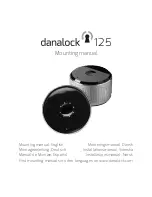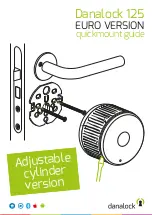
D41L
19
1.
Do not drop the product to the ground or expose to excessive
vibration or mechanical shocks. Doing so may damage the product
and cause failure.
2.
Do not store or use the product under the following conditions.
Doing so may damage the product and cause failure.
1) At ambient operating temperatures out of the range of 0 to 60°C
2) At ambient storage temperatures out of the range of -10 to 90°C
3) At relative humidity of 93% or more
4) In direct sunlight
5) Under drastic temperature changes
6) In high humidity that causes condensation
3.
Keep the product away from oil or solvent. Oil or solvent make the
marking on the product illegible and cause deterioration of some
parts.
4.
Do not use in an environment with corrosive gas.
5.
The product may not operate normally in the vicinity of devices that
generate strong radio waves or magnetic fields, such as RFID
systems, proximity sensors, motors, inverters, and switch-mode
power supplies. If the device is used in the vicinity of such devices,
check the effect before use.
6.
Installing the switch and the actuator on a metallic material may
affect the operating distance. If installation on a metallic material
is necessary, be sure to check the effect on the operating distance
before use.
7.
Tighten the screws with a specified torque.
8.
Use the wires specified by OMRON to wire the product.
(Refer to Connection.)
9.
Do not extend the cables in excess of the specification of this
product. Carry out electrical connection according to the wiring
examples shown in this document and verify the correct operation
of the product.
10.
Do not pull or bend the cable excessively. A disconnection may
cause a malfunction.
11.
Risk time remains unchanged by series connection. However,
carry out electrical connection according to the wiring examples
shown in this document.
12.
Be sure to inspect the product daily and every 6 months. Failure to
do so may cause a system failure and serious injury.
13.
When determining the safety distance, take into account the delay
of the output of the product caused by the response time. Failure
to do so may cause the operator to reach the hazardous source
before the machine is stopped, resulting in serious injury.
14.
During installation, make sure that the safety door switch does not
come in contact with the actuator due to rattling of the guard door.
(The performance of the product may be degraded by a collision
caused by opening or closing the guard door.)
15.
Install the product so that the LED indicators of the safety door
switch are as visible as possible. Misinterpreting the status of the
safety door switch may result in danger.
16.
Do not use the product at an altitude of 2,000 m or higher.
17.
Do not connect a product different from this product in series with
this product. Doing so may disturb waveforms of the input and
output signals, leading to loss of the safety function.
18.
Do not use the product in the water or continuous water exposure
environment. Doing so may cause water to leak into the product.
(The degree of protection does not guarantee the protection under
continuous water exposure environment.)
19.
Do not tamper the product with a replacement actuator. Store
replacement actuators in a safe place where they cannot be easily
reached.
20.
Build a safety system using the outputs of both Safety Outputs 1
and 2. Wiring with only one safety output may lead to loss of the
safety function due to a single failure.
21.
Wiring should meet the requirements specified in Section 9.4.3 of
IEC 60204-1 to prevent malfunction due to ground faults in the
safety output lines.
22.
In the power-to-lock type, close the door before energizing the
safety door switch.
23.
In the power-to-lock type, the safety door switch is locked only
when the solenoid is energized. If the solenoid is de-energized due
to a sudden power failure, the operator may be exposed to a
hazardous source. Use the power-to-lock type only for process
protection.
24.
Do not use the emergency-exit type for switching the machine on
and off. Doing so may place operators at risk due to being trapped
inside or unexpected operation of the machine.
25.
Install the emergency-exit type so that it cannot be operated from
outside a safety zone.
26.
Do not apply excessive force on the actuator while the actuator is
inserted into the switch body or do not drop the product. Doing so
may deform the actuator or damage the switch body.
27.
The safety function may not operate normally due to a malfunction
of the wiring, setting, or switch, and the machine may continue to
operate, which may result in personal injury. Make sure that the
safety function works before starting operation.
28.
The current consumption of the safety door switch is different
between when it is turned on and when it is in a normal operation.
Apply the supply voltage to the safety door switch in consideration
of the voltage drop in the wiring.
29.
Do not turn beyond the latching point. After being put into
operation, the manual release must be secured by closing the flap
cover with the seal, which is included in delivery.
30.
After installation of the product, qualified personnel should verify
to see that the installation, inspection, and maintenance are
properly performed. The qualified personnel should be qualified
and authorized to secure the safety on each phase of design,
installation, running, maintenance and disposal of system.
31.
Do not wire the product to an input of a safety controller in parallel.
32.
Disconnect the product and the controller connected to the product
from power supply when replacing the product. Failure to do so
may cause unexpected operation of devices connected to the
product.
33.
Install the product to a position near a handle of the guard door.
Installing it near a hinge may cause the locking part of the product
to receive larger load than the operating force, leading to damage
to the locking mechanism.
34.
Do not try to disassemble, repair, or modify the product. Doing so
may cause loss of the safety function.
35.
Do not operate the product in an environment with flammable or
explosive gas.
36.
Auxiliary output is NOT a safety output. Do not use the Auxiliary
output individually for any safety function. Such incorrect use
causes loss of the safety function of the product and its relevant
systems.
Precautions for Correct Use




































